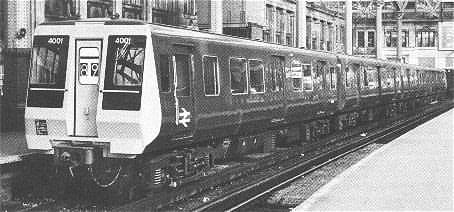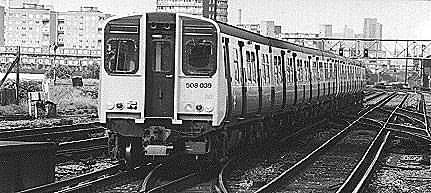
Suburban Electric Railway Association
Located at the COVENTRY ELECTRIC RAILWAY CENTRE, Rowley Road, Baginton, Warwickshire
Established
1996
The History Zone
The Southern Suburban Electric Network
Part 5 - British Railways Southern Region Suburban EMUs
British Railways came into being on January 1st 1948 when all of the UKs' rail services were nationalised. The lines previously under the Southern Railway became the Southern Region.
As far as suburban EMU construction went the early years of BR witnessed only the completion of EMU types ordered prior to nationalisation, such as the last batches of 4-SUB, 2-HAL and the 4-DD prototypes. By late 1951 the first BR ordered EMUs began to be constructed.
The EPB Units
The first unit numbered 5001 (pictured left) appeared from Eastleigh works late in 1951 The style of construction and the unit layout and formation was basically the same as that of the last batch of 4-SUB units but it featured a redesigned cab end complete with roller blind route indicators along with buckeye automatic couplers and a new style of multiple working jumpers. The major departure from the SUB design was the units electrical system which was completely redesigned to work on two voltages, the traction equipment was supplied from the 750V third rail but all control and lighting was fed by a 70V circuit produced by an on board motor-generator set. The braking type employed gave the units their name. The Electro Pneumatic Brake featured a system that allowed the driver to electrically inject air into the unit's brakes at an even rate making for smoother and faster deceleration. The last of the 213 4-EPB units inspired by the Bulleid design emerged in 1957. By this time new suburban stock was being constructed to the British Railway standard design. A style of unit that drew heavily on the 4-EPB units in it's construction. A batch of 2-EPB units with the SUB style body was built in 1959 on the underframes of the 2-NOL units.
The BR standard version of the EPB design was also built in 2 and 4 coach variant, the 2 car units came first from 1954 with the 4 car ones appearing from 1957. The units had the slightly longer BR standard underframe of 63' and the classic Mk.1 Coach body profile. The 4 car sets also featured an updated motor control circuit.
EPB stock worked on all three divisions of the Southern Region and the last examples were not withdrawn until 1995.
The 2-HAP Units
During 1956 construction of 36 new units on the reclaimed underframes of 2-NOL units commenced. These were the first to the 2-HAP design that was to be introduced to semi-fast and outer suburban duties over the next two years. The first batch featured the SUB style body outline with a driving motor brake and driving trailer composite, the later coach also had a toilet at its inner end.
At the same time as these units began construction a fleet of all new BR standard 2-HAP was authorised with the same body style as the BR 2-EPB sets but the layout of composite accommodation in the driving trailer car separated by two toilets. 42 units made up this batch of BR HAPS and they were supplemented by the construction of three more batches in 1958 (63 units), 1961 (41 units) and finally 1963 (27 units). The layout of all the BR style batches was identical but changes were made to the electrical control equipment and bogies in later batches.
HAPS worked on all three divisions of the Southern Region on a variety of duties. The SUB style units were downgraded to second class only for suburban duties in the 1970s and re-classified as 2-SAP units, they were all withdrawn in the early 1980s. Pairs of HAP units were semi-permanently coupled together as 4-CAP units in 1982 for the stopping trains on the coastal routes from Brighton but these soon transferred to suburban duties on the South Eastern division.
The last HAP and CAP units continued in traffic until 1995.
The 4-PEP Units
The 1960s on the Southern Region was concentrated on main line electrification with the suburban routes left to soldier on with units provided by the Southern Railway and BR (Southern). It was not until the end of that decade that thoughts could turn to the much needed modernisation of suburban rolling stock.
A concept for a standard type of EMU was drawn up that could be adapted for use on DC and AC lines and built accordingly to local requirements but based on that same basic standard pattern. To trial the finalised concept three prototype trains were constructed - two four car units and one two car. All were built at York works with the 4 cars delivered for testing on the Southern Region (as they were equipped for third rail operation) in 1971, the 2 car set arrived a year later. The PEP units, as they were designated, featured practices that had been adopted as standard on the London Underground for many years. The layout of all cars was open saloon with generous provision for standing passengers in peak hours. Each car had two sets of air operated sliding doors per side and interior finishing was made of plastic and laminates. Car interiors were lt with fluorescent tubes and provided with pressure ventilation and the units were gangwayed within each set but had no brake van - the guard occupied one of the unused driving cabs on the train where door control panels were provided. Brake equipment was EP and also rheostatic for the first time on a BR EMU with disc brakes fitted. The unit ends had no brake or electrical coupling pipes and jumpers as all couplings of this nature were incorporated into the 'Scharfenberg' automatic coupler.

The units were tested mainly on the South Western division suburban routes from Waterloo to Shepperton, Hampton Court and Chessington South. During 1974 the 2 car unit was transferred to test duties on the Eastern Region and had a new vehicle built for it so it could run on AC overhead lines. The two four cars continued in use until 1976 when they were transferred to departmental stock. After long periods of store both were broken up during the 1980s.
The Class 508 Units
Following on from the prototype PEP units BR ordered several batches of new generation suburban units during the mid 1970s. The four car class 508s were one such design, emerging from York works in 1979. 43 units were built and their styling and formation was near identical to that of the 4-PEP prototypes. The two outer driving cars were also the motor coaches and each one had each axle powered by a 110hp GEC traction motor. The units also had secondary air suspension.

The first passenger run was in December of 1979 with the full compliment of units in traffic by the summer of the following year on South Western division suburban traffic. The introduction of the 508 units allowed the last of the 4-SUB units to be withdrawn so that their electrical equipment could be reclaimed for use in the new class 455 units. As the 455s were introduced so the 508s were transferred away from the Southern to Merseyside but only as three car sets as one 508 trailer from each unit was retained for use in a batch of 455 units. The last 508s left the south in 1983.
The Class 455 Units
These were originally classified as class 510 units but that was changed to class 455 to fit them in with the existing TOPS numbering of southern EMUs prior to delivery. The 455s were built in three batches. All were formed as four car sets with driving trailer coaches marshaled either side of a intermediate trailer and a non-driving motor coach which carried all the traction equipment (four 250hp motors reclaimed from 4-SUB units). The layout was the same as the 508 units but the body shell was not of the style that derived from the PEP prototypes but a shortened version of the Mk.3 coach body.
The first batch delivered in 1982 were the 455/8 variants which were split between the Central and South Western divisions. The second (class 455/7 - 43 units) and third (class 455/9 - 20 units) batches were only used on the South Western division and were delivered in 1984/5. Both final batches had a revised front end to that of the 455/8 type and the 455/7 featured the trailers recovered from the 508 units. The 455/9s had no pressure ventilation and the last few built examples had a new system of traction control know as 'Chopper Control'.


Above Left - Class 455/7 and Above Right Class 455/8
